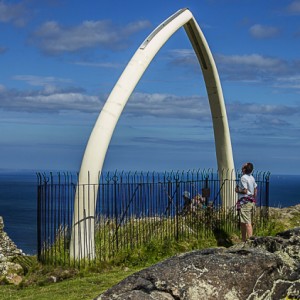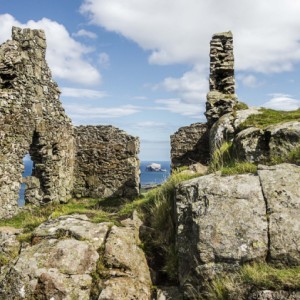The Horse‘s Arse.
I do like to include people in my landscapes though, perhaps foreigners with a passion about the back ends of horses is not the best choice. I’ve always been fond of Pieter Bruegel the Elder‘s painting, “The Fall of Icarus,“ a landscape with the incongruity of a pair of legs disappearing into the sea as the rash young Icarus meets his demise. It is the absurdity that is the common factor that appeals.
The cycle run today started in Kelso, that’s an hour’s drive each way which could be better spent doing something interesting like cycling, or even taking photographs. Instead, I cycled to Berwick Law to walk up it looking for blips. The route went past the now see-through Cockenzie power station (first extra); what will probably be the final stage in its destruction, the blowing up of the twin chimneys, will take place next month - I have my seat booked.
Having had some refreshment at the Sea Bird Centre at North Berwick I proceeded in a southerly direction, as directed by the satnav. The intended road had disappeared under a housing estate and, as I was extricating myself, I was stopped by an elderly gentleman. He had seen a few trikes before, but not many, and his conversation delayed me by some 30 minutes. He has cycled all over Britain and we were able to compare notes on riding in London and the home counties and the relative merits of bikes in Harlow (Essex new town) and Livingstone (East Lothian new town).
Having found the Berwick Law car park (full of earth moving machinery and closed to cars) I tucked the trike out of the way in the hedge and made my way up the hill. For those who are unfamiliar with it, the Law is a volcanic plug that was denude of the softer rock that used to encase it by the glaciers of the last ice age. Being a 600 foot high conical hill, it commands spectacular views of the surrounding countryside. In spite of today being the first day back at school, the summit was hooching with people in unsuitable clothing, many of whom were of school age; in particular, there was a strange foreign gentleman taking photographs of odd items - not to mention inspecting the whalebone from curious angles (second extra). Whalebones have been here since 1709, the most recent one was installed in 1933 and survived until its removal in 2005 when it became dangerous. This fibre-glass model was donated by an anonymous benefactor four years later. The next extra is a view of the Bass Rock from a derelict building used as a lookout during the last war.
As with the nearby Traprain Law, Exmoor ponies are used to maintain the diversity of species by eating some of them.
The final extra is the solution to yesterday’s Mystery Macro.




Comments
Sign in or get an account to comment.


